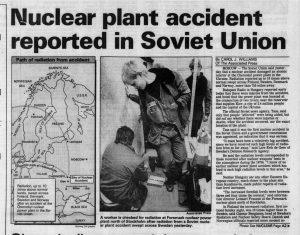
Chernobyl Disaster newspaper headline (The Morning Call via Newspapers.com)
On April 26, 1986, a Soviet nuclear power plant near Chernobyl, Ukraine, became the site of the most disastrous nuclear accident in history, when it experienced explosions at one of its reactors.
Disaster
In the early hours of April 26, a planned simulation of an electrical power outage resulted in an uncontrolled nuclear reaction at the Chernobyl Nuclear Power Plant’s Unit 4 reactor. At 1:23 a.m., the reactor exploded, releasing radioactive debris into the atmosphere. A second explosion followed a few seconds later. These explosions caused a fire at the reactor that would take more than a week to contain.
Two workers were reported killed as a result of the explosions, but 28 more people would later die as a result of acute radiation poisoning.
Aftermath
The day after the explosion, the nearby town of Pripyat was evacuated. However, the Soviet government kept the nuclear disaster from the international community until April 28, after a Swedish monitoring station reported unusually high levels of wind-borne radiation.
By mid-May, everyone in a 19-mile radius of the power plant had been evacuated. By December, a concrete-and-steel sarcophagus was erected around the reactor to limit radiation emission; this dome was itself later enclosed in a protective structure completed in 2017.
Effects
Following the disaster, radioactive fallout fell across Ukraine, Russia, and Belarus, and to a more limited extent over Scandinavia and other parts of Europe.
Due to a lack of reliable pre-1986 health data, long-term health effects from the radiation are difficult to conclusively discern, though an increase in thyroid cancer may be linked. Beyond the potential health effects, the Chernobyl disaster also had political consequences. In fact, former Soviet leader Mikhail Gorbachev named the Chernobyl disaster as an important factor in the collapse of the Soviet Union.
The Chernobyl power station was officially decommissioned in 2000. The 1,600-square-mile Chernobyl Exclusion Zone is still considered unsafe for human habitation.
Learn more about the Chernobyl Disaster through historical newspapers from our archives. Explore newspaper articles, headlines, images, and other primary sources below.
Articles and Clippings about the Chernobyl Disaster
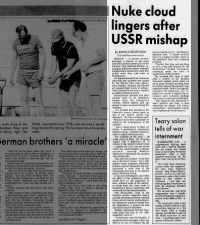 Early United States news coverage of the Chernobyl nuclear disaster in Ukraine Mon, Apr 28, 1986 – 1 · The Press-Tribune (Roseville, California) · Newspapers.com
Early United States news coverage of the Chernobyl nuclear disaster in Ukraine Mon, Apr 28, 1986 – 1 · The Press-Tribune (Roseville, California) · Newspapers.com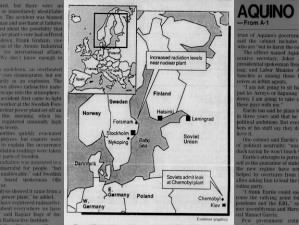 Map showing location of Chernobyl and where the increased radiation levels were detected in Sweden Mon, Apr 28, 1986 – 12 · The San Francisco Examiner (San Francisco, California) · Newspapers.com
Map showing location of Chernobyl and where the increased radiation levels were detected in Sweden Mon, Apr 28, 1986 – 12 · The San Francisco Examiner (San Francisco, California) · Newspapers.com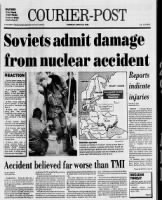 U.S. front page coverage of the Chernobyl disaster from April 29, 1986 29 Apr 1986, Tue Courier-Post (Camden, New Jersey) Newspapers.com
U.S. front page coverage of the Chernobyl disaster from April 29, 1986 29 Apr 1986, Tue Courier-Post (Camden, New Jersey) Newspapers.com "Deaths feared after Soviet nuclear accident"; No fallout detected in Canada Tue, Apr 29, 1986 – 1 · Edmonton Journal (Edmonton, Alberta, Canada) · Newspapers.com
"Deaths feared after Soviet nuclear accident"; No fallout detected in Canada Tue, Apr 29, 1986 – 1 · Edmonton Journal (Edmonton, Alberta, Canada) · Newspapers.com British newspaper articles and political cartoon from the early days of the Chernobyl disaster Wed, Apr 30, 1986 – 7 · The Guardian (London, Greater London, England) · Newspapers.com
British newspaper articles and political cartoon from the early days of the Chernobyl disaster Wed, Apr 30, 1986 – 7 · The Guardian (London, Greater London, England) · Newspapers.com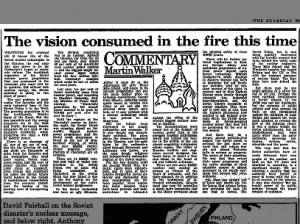 Op-ed discussing potential economic and political fallout of the Chernobyl disaster Wed, Apr 30, 1986 – 23 · The Guardian (London, Greater London, England) · Newspapers.com
Op-ed discussing potential economic and political fallout of the Chernobyl disaster Wed, Apr 30, 1986 – 23 · The Guardian (London, Greater London, England) · Newspapers.com Australian newspaper coverage from the early days of the Chernobyl disaster Wed, Apr 30, 1986 – Page 1 · The Age (Melbourne, Victoria, Australia) · Newspapers.com
Australian newspaper coverage from the early days of the Chernobyl disaster Wed, Apr 30, 1986 – Page 1 · The Age (Melbourne, Victoria, Australia) · Newspapers.com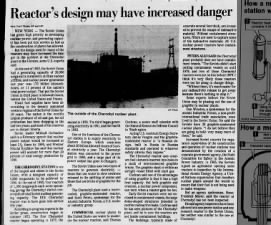 Chernobyl "reactor's design may have increased danger" Wed, Apr 30, 1986 – Page 15 · Detroit Free Press (Detroit, Michigan) · Newspapers.com
Chernobyl "reactor's design may have increased danger" Wed, Apr 30, 1986 – Page 15 · Detroit Free Press (Detroit, Michigan) · Newspapers.com U.S. scientists speculate about cause of Chernobyl disaster before Soviets release the details Wed, Apr 30, 1986 – Page 13 · The Philadelphia Inquirer (Philadelphia, Pennsylvania) · Newspapers.com
U.S. scientists speculate about cause of Chernobyl disaster before Soviets release the details Wed, Apr 30, 1986 – Page 13 · The Philadelphia Inquirer (Philadelphia, Pennsylvania) · Newspapers.com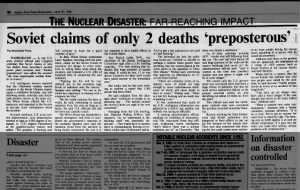 U.S. official says Soviet claims of only 2 deaths in Chernobyl disaster are "preposterous" Wed, Apr 30, 1986 – Page 6 · Asbury Park Press (Asbury Park, New Jersey) · Newspapers.com
U.S. official says Soviet claims of only 2 deaths in Chernobyl disaster are "preposterous" Wed, Apr 30, 1986 – Page 6 · Asbury Park Press (Asbury Park, New Jersey) · Newspapers.com "Angry Europeans monitor fallout" from the Chernobyl disaster Thu, May 1, 1986 – Page 35 · The Anniston Star (Anniston, Alabama) · Newspapers.com
"Angry Europeans monitor fallout" from the Chernobyl disaster Thu, May 1, 1986 – Page 35 · The Anniston Star (Anniston, Alabama) · Newspapers.com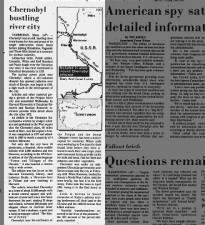 Article describing city of Chernobyl, Ukraine, prior to the nuclear disaster in April 1986 Thu, May 1, 1986 – Page 35 · The Anniston Star (Anniston, Alabama) · Newspapers.com
Article describing city of Chernobyl, Ukraine, prior to the nuclear disaster in April 1986 Thu, May 1, 1986 – Page 35 · The Anniston Star (Anniston, Alabama) · Newspapers.com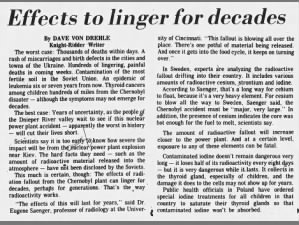 Health effects from Chernobyl disaster predicted "to linger for decades" Thu, May 1, 1986 – Page 35 · The Anniston Star (Anniston, Alabama) · Newspapers.com
Health effects from Chernobyl disaster predicted "to linger for decades" Thu, May 1, 1986 – Page 35 · The Anniston Star (Anniston, Alabama) · Newspapers.com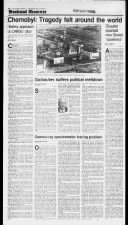 Canadian newspaper articles about the Chernobyl disaster from a few weeks after the accident Sat, May 17, 1986 – 30 · The Ottawa Citizen (Ottawa, Ontario, Canada) · Newspapers.com
Canadian newspaper articles about the Chernobyl disaster from a few weeks after the accident Sat, May 17, 1986 – 30 · The Ottawa Citizen (Ottawa, Ontario, Canada) · Newspapers.com Newspaper opinion pieces about the Chernobyl nuclear disaster, published weeks after the meltdown Tue, Jun 10, 1986 – Page 25 · St. Louis Post-Dispatch (St. Louis, Missouri) · Newspapers.com
Newspaper opinion pieces about the Chernobyl nuclear disaster, published weeks after the meltdown Tue, Jun 10, 1986 – Page 25 · St. Louis Post-Dispatch (St. Louis, Missouri) · Newspapers.com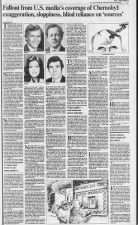 Op-ed: "Fallout from U.S. media's coverage of Chernobyl: exaggeration, sloppiness" Fri, Jul 25, 1986 – Page 9 · The Des Moines Register (Des Moines, Iowa) · Newspapers.com
Op-ed: "Fallout from U.S. media's coverage of Chernobyl: exaggeration, sloppiness" Fri, Jul 25, 1986 – Page 9 · The Des Moines Register (Des Moines, Iowa) · Newspapers.com "Worst postwar accident causes wide repercussions" Sun, Nov 2, 1986 – 5 · Times Colonist (Victoria, British Columbia, Canada) · Newspapers.com
"Worst postwar accident causes wide repercussions" Sun, Nov 2, 1986 – 5 · Times Colonist (Victoria, British Columbia, Canada) · Newspapers.com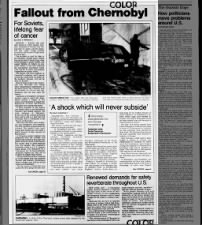 Reflections on the Chernobyl nuclear accident and its effects a year after the disaster Sun, Apr 26, 1987 – Page 33 · Reno Gazette-Journal (Reno, Nevada) · Newspapers.com
Reflections on the Chernobyl nuclear accident and its effects a year after the disaster Sun, Apr 26, 1987 – Page 33 · Reno Gazette-Journal (Reno, Nevada) · Newspapers.com "Chernobyl erodes support for nuclear power" Sun, Apr 26, 1987 – 6 · Wausau Daily Herald (Wausau, Wisconsin) · Newspapers.com
"Chernobyl erodes support for nuclear power" Sun, Apr 26, 1987 – 6 · Wausau Daily Herald (Wausau, Wisconsin) · Newspapers.com "Chernobyl remembered throughout the world" on the first anniversary of the disaster Mon, Apr 27, 1987 – 4 · Public Opinion (Chambersburg, Pennsylvania) · Newspapers.com
"Chernobyl remembered throughout the world" on the first anniversary of the disaster Mon, Apr 27, 1987 – 4 · Public Opinion (Chambersburg, Pennsylvania) · Newspapers.com "Chernobyl: The horror continues to unfold"--Article about the human toll of the Chernobyl disaster Tue, Mar 19, 1991 – Page 7 · Journal Gazette (Mattoon, Illinois) · Newspapers.com
"Chernobyl: The horror continues to unfold"--Article about the human toll of the Chernobyl disaster Tue, Mar 19, 1991 – Page 7 · Journal Gazette (Mattoon, Illinois) · Newspapers.com "8 years after the Chernobyl disaster, it's still a disaster" Sun, Dec 11, 1994 – Page 106 · The Courier-Journal (Louisville, Kentucky) · Newspapers.com
"8 years after the Chernobyl disaster, it's still a disaster" Sun, Dec 11, 1994 – Page 106 · The Courier-Journal (Louisville, Kentucky) · Newspapers.com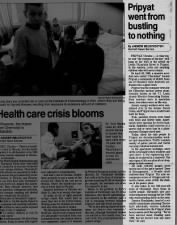 Effects of Chernobyl disaster on the city of Pripyat, Ukraine Mon, Apr 22, 1996 – Page 4 · The Courier-News (Bridgewater, New Jersey) · Newspapers.com
Effects of Chernobyl disaster on the city of Pripyat, Ukraine Mon, Apr 22, 1996 – Page 4 · The Courier-News (Bridgewater, New Jersey) · Newspapers.com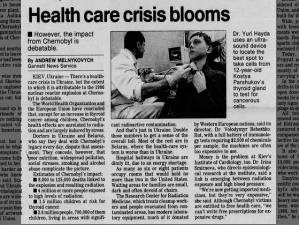 Article says link between health crisis in Ukraine and Chernobyl disaster "is debatable" Mon, Apr 22, 1996 – Page 4 · The Courier-News (Bridgewater, New Jersey) · Newspapers.com
Article says link between health crisis in Ukraine and Chernobyl disaster "is debatable" Mon, Apr 22, 1996 – Page 4 · The Courier-News (Bridgewater, New Jersey) · Newspapers.com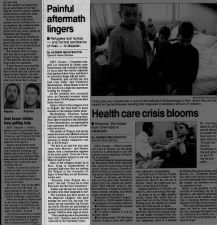 Chernobyl refugees speak about the disaster 10 years later Mon, Apr 22, 1996 – Page 4 · The Courier-News (Bridgewater, New Jersey) · Newspapers.com
Chernobyl refugees speak about the disaster 10 years later Mon, Apr 22, 1996 – Page 4 · The Courier-News (Bridgewater, New Jersey) · Newspapers.com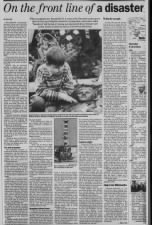 Article about the effects of Chernobyl disaster on firefighters, "liquidators," and others Mon, Apr 29, 1996 – Page 7 · Star Tribune (Minneapolis, Minnesota) · Newspapers.com
Article about the effects of Chernobyl disaster on firefighters, "liquidators," and others Mon, Apr 29, 1996 – Page 7 · Star Tribune (Minneapolis, Minnesota) · Newspapers.com "Chernobyl closing brings little solace" Fri, Dec 15, 2000 – Page 3 · Chicago Tribune (Chicago, Illinois) · Newspapers.com
"Chernobyl closing brings little solace" Fri, Dec 15, 2000 – Page 3 · Chicago Tribune (Chicago, Illinois) · Newspapers.com